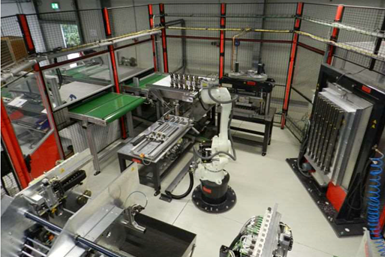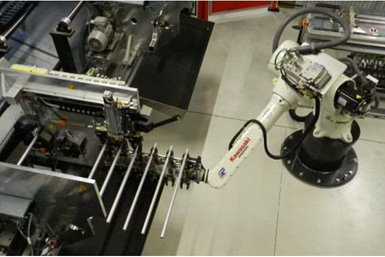Robotic Cell Increases Production Volume Across Wide Catalog
Kawasaki’s robots cut Ossenberg’s pipe processing times by over four minutes and boosted production volume to over 10,000 parts per day.
Share






The Kawasaki RS020N is the centerpiece of Ossenberg’s automation cell. This robot positions pipes for its RS050N counterpart to mill, a combination that reduces processing time by almost 85%. Photos courtesy of Ossenberg.
is a long-standing German developer, manufacturer and distributor of crutches, light metal canes and orthopedic aids for global retailers. In response to swift growth and increased product demand, management decided to automate the company’s pipe processing operations. After implementing a robotics cell that could handle Ossenberg’s wide product range, the company’s pipe processing cycle times plummeted almost 85%.
Precise for Every Product
As Ossenberg’s standard walking aids are available in 850 variants, including multiple colors, different materials, adaptable sizes and different load capacities, any potential robotic system would require a high degree of flexibility.
Precision was also a high priority. As part of the efficiency-increasing changes it was implementing alongside automation, Ossenberg planned to mill height-adjustment holes into pipes instead of drilling or punching them. For pipe processing, the company required 0.1-mm positional repeatability and +0.05-mm drilling accuracy. The pipes would also require deburring from the inside and outside at the same time.
Two Robots, One System
While pipe processing cycle times were 5.5 minutes before the company implemented its robotic cell, the new system simultaneously processes six pipes within 50 seconds.
Now pipes are processed by two robots in a 20-foot × 30-foot cell. An RS020N robot moves the welding seam to the correct side for precise alignment, then moves the pipes toward a fixture where an RS050N robot equipped with milling tools mills the height-adjustment holes into the pipes from both sides.
During the final step, the robots can automatically attach the spring-operated push buttons for height adjustment. Depending on the product requirements, they can also recognize bending angles within the outer pipe component.

Success in producing Ossenberg’s parts required adherence to strict repeatability and accuracy standards: a positional repeatability of 0.1 mm and a drilling accuracy of +0.05 mm. By comparison, riveting airplane parts requires an accuracy of 0.3 mm.
Success and Stability
Ossenberg’s production volume and efficiency increased almost instantly. While pipe processing cycle times were 5.5 minutes before the company implemented its robotic cell, the new system simultaneously processes six pipes within 50 seconds. On a macro scale, this increased the plant’s production capacity from over 1,000 walking aids per day to more than 10,000.
“The automation made possible by the Kawasaki robots increased our output exponentially,” says Ossenberg’s managing director, Dietmar Fark. “And there is still room for more. Through specific process improvement, we plan to decrease the time necessary for six pipes to 45 seconds.”
Related Content
-
How to Accelerate Robotic Deburring & Automated Material Removal
Pairing automation with air-driven motors that push cutting tool speeds up to 65,000 RPM with no duty cycle can dramatically improve throughput and improve finishing.
-
5 Stages of a Closed-Loop CNC Machining Cell
Controlling variability in a closed-loop manufacturing process requires inspection data collected before, during and immediately after machining — and a means to act on that data in real time. Here’s one system that accomplishes this.
-
Increasing Productivity with Digitalization and AI
Job shops are implementing automation and digitalization into workflows to eliminate set up time and increase repeatability in production.















